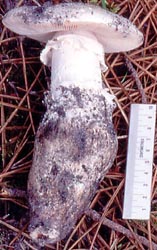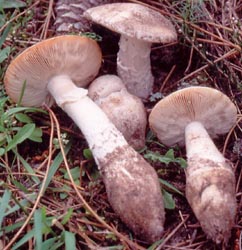|
[ Section Lepidella page. ] [ Amanita Studies home. ] [ Keys & Checklist/Picturebooks ] Amanita gilbertii Beauseign."Gilbert's Limbed Lepidella"
Technical description (t.b.d.) BRIEF DESCRIPTION: The following is based on the original description by Beauseigneur (1925). The cap of Amanita gilbertii is 60 - 150 mm wide, pure satin white, then dirty white, finally slightly ochraceous and butter yellow, convex at first, then plano-convex, rarely depressed, with a rarely striate margin (in slender individuals and past maturity). The volva remnants as large, membranous, thin patches and no more than three in number; at first appressed to the cap and difficult to notice, The flesh is thick even up to the margin. The gills are rounded at the margin, touching to the stem, and are connected to striations on the top of the stem. The short gills are truncate. The stem is 80 - 200 × 20 - 30 mm, smooth, white. The bulb is 20 - 60 mm wide, turnip-like and rooting. The ring is large, membranous, placed always very high on the stem, striate on the upper surface, white, and persisting throughout the life of the fruiting body. The volva remnants on the bulb form a limb and as the limb dries and shrinks, it pressed up against a rounded, short, limbus internus. From the exterior, the limb often looks like it is compressed against a rounded bracelet. The limb extends for 10 - 20 mm beyond the "bracelet." The spores measure 11 - 15 × 9 - 12 µm and are amyloid and oblong to cylindric. Clamps are absent at bases of basidia. Neville and Poumarat (2004) provide spores measurements which follow: (9-) 10 - 16 (-17) × (4.5- ) 5 - 6 (-6.5) µm and are elongate to cylindric, rarely bacilliform and amyloid. RET's spore measurements from French and Moroccan material are (7.7-) 9.7 - 14.4 (-21) × (4.2-) 4.5 - 6.3 (-9.2) µm. The present species was originally described from the département of Landes in southwestern France. It was originally described from pine (Pinus) forests growing in sand of the Atlantic Coastal Plain. It is also known to occur around the Mediterranean and in southern Germany. Neville and Poumarat added the following to the list of possibly associated woody plants: oak (Quercus), chestnut (Castanea), Acacia, Arbutus, and Eucalyptus. Ulex and Pteris are also said sometimes to be in the vicinity. Because of the elongate spores (alone?) this species has often been placed in section Amidella. For a while, RET considered the possibility that this species could be placed in section Phalloideae. However, recent morphological and chemical studies caused a second reassessment of its placement: A probable "sister species" (vicariant) of A. gilbertii (A. cylindrispora Beardlee) does not contain amatoxins, which is a common character of all the white species known in section Phalloideae; RET was struck by the many morphological similarities between the present species and A. cylindrispora; and the probability of high genetic similarity between A. cylindrispora and A. gilbertii is supported in soon to be published molecular research ( H. E. Hallen et al., pers. comm.). Given what is known of the rather rare limbate volva'd species of section Lepidella (including the presence of extremely narrow spores), it now seems the best choice for placement of the two sister taxa is in Amanita [section Lepidella] subsection Limbatulae Bas. Note: When re-reading Beauseigneur's description of this species one is always struck by a sense of modernity rarely if ever shared in descriptions from the period in which he worked (over 80 years before the date on which this page was originally published--2006). We call special attention to the quality of his microscopy and the number of tissues for which microscopic descriptions are given. -- R. E. Tulloss and L. Possiel Photos: Francis Massart (Gironde, France) [ Section Lepidella page. ] [ Amanita Studies home. ] [ Keys & Checklist/Picturebooks ] Last changed 6 March 2009. |

